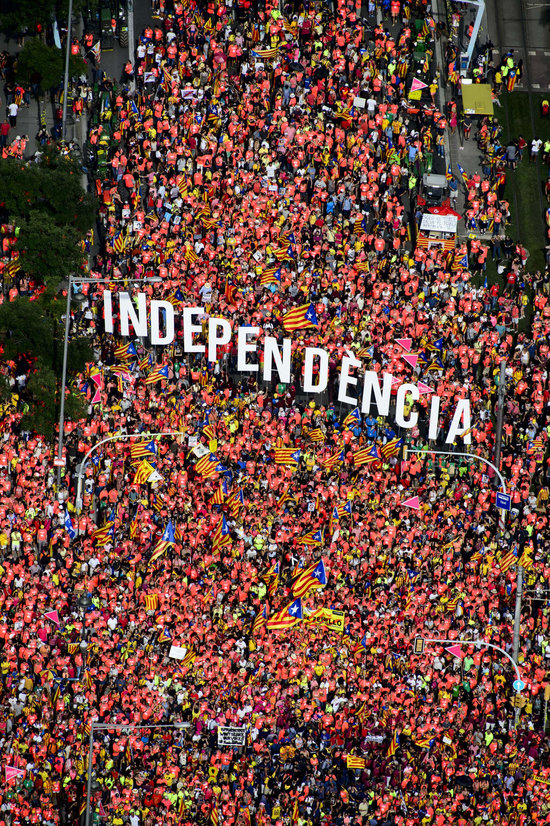Catalonia National Day rallies: the saga continues
Leading up to 2019’s September 11 demonstration, here’s a rundown of the last seven years of protests

September 11 commemorates the Diada Nacional de Catalunya, dedicated to the fall of Catalonia after the Succession War in 1714.
On this day, for the past 7 years, citizens of Catalonia have been rallying for the independence of their state. Every year, between 800,000 and 1.8 million people have taken to the streets, using the bank holiday as a platform for demanding self-determination. However, the mass crowds are not the only thing unique about these protests. Every year is different, and with the verdict of the Catalan trial looming, Catalonia will once again be rather noisy on September 11.
2012: And so it begins
The first September 11 demonstration was called by the pro-independence Catalan National Assembly in 2012. Their motto and objective was simple: “Catalonia, new European state:”
There is some debate over how many people actually turned up, in what would become something of a trend in future demonstrations. The organizers claimed that they managed to assemble 2 million people, while the Spanish government delegation in Catalonia rebuked this, stating that there were 600,000. Meanwhile, the Catalan government and local police found a middle ground, estimating that there were 1.5 million people, perhaps a more reliable figure.
The Catalan president at the time and leader of CiU party, Artur Mas, traveled to Madrid after the protests to demand a better fiscal deal for Catalonia from his Spanish counterpart, Mariano Rajoy. Rajoy rejected the requests, and Mas started advocating for Catalonia’s right to self-determination. This marked the beginning of seven years (and who knows how much longer) of talk of independence in Catalonia.
2013: Citizens lock arms in 400km chain
The Catalan National Assembly and Òmnium Cultural organized a rally inspired by that of 1989, when people joined hands across Estonia, Latvia, and Lithuania to protest against the USSR.
Catalan citizens stood similarly together in arms, connecting the Northern and Southern borders of the country. The Camp Nou even opened its doors so that the chain could continue through there. Participants for this year were estimated at 1.6 million.
2014: Streets overflow as figures reach a staggering 1.8 million
Two months before the non-binding November 9 vote on independence, protesters made it pretty clear what they would be voting for.
Protesters wore yellow and red t-shirts and formed a giant V with the colors of the Catalan flag through two of Barcelona’s major streets, Gran Via and Diagonal.
Figures were estimated at 1.8 million for this year, and the figure has not been surpassed since. The culmination of the protests was at 5.14pm, when out of all 1.8 million people, one girl put her vote inside a ballot box, placed at the point of the V. The time chosen represented the year 1714, when Catalonia was defeated by Spain in the Succession War and lost political independence.
2015: Values of the future Catalan Republic
In 2015, the republic laid out plans for their future. Protesters, this year estimated at 1.4 million, carried pointed banners.
Citizens were divided into ten variously colored sections, each representing a different value of the future Catalan republic. Values included social justice, solidarity, culture, democracy, and sustainability.
2016: Protesters extend sphere of influence
Protesters this year spread across five different cities across Catalonia: Berga, Barcelona, Lleida, Salt, and Tarragona. Once again the divide represented different dimensions of Catalonia as an independent state. However, this year the number of protesters more than halved to 800,000.
2017: Run-up to the referendum
Less than three weeks before the October 1 referendum on independence, the September 11, 2017, protests were known as the ‘Diada del Sí’ (‘National Day of Yes’), given what protesters hoped the outcome of the referendum would be.
Protesters were brought on buses from all around the country wearing yellow shirts for independence. Protesters held a minute of silence in memory of the victims of the Barcelona and Cambrils terrorist attacks in August of that same year.
This year protesters opted to shape the demonstration at the intersection of major roads, in the shape of a ‘plus’ sign. Giant pro-independence banners were also passed along over the crowds. Crowds for this year were estimated to be at around 1 million.
2018: A fight to free political leaders
Protesters congregated last year to demand the release of jailed political leaders, who were charged for calling a referendum and trying to split from Spain in 2017.
The number of protesters was comparable to the previous year, estimated at around 1 million.
This year, protesters were dressed in t-shirts bearing the slogan: ‘We’re making the Catalan republic.’
Much like in 2014, at 5.14pm an act of symbolism was carried out, once again representing the fall of Catalonia in 1714. Total silence fell, followed by a wave of sound that rumbled from one end of Diagonal to the other, where a wall was toppled, representing the direct rule imposed by Madrid following the independence referendum.
2019: Unity is the way forward
The slogan for this year’s protests is “Objective: Independence”, and organizers from the Catalan National Assembly are urging pro-independence political parties and groups to lead with a “common objective.”
Once again, protests will be dedicated to the political prisoners and exiles, and this year will take place in Barcelona’s Plaça Espanya, the intersection of a number of Barcelona’s main avenues. According to Catalan National Assembly head Elisenda Paluzie, the square represents “a meeting point that is independence.”